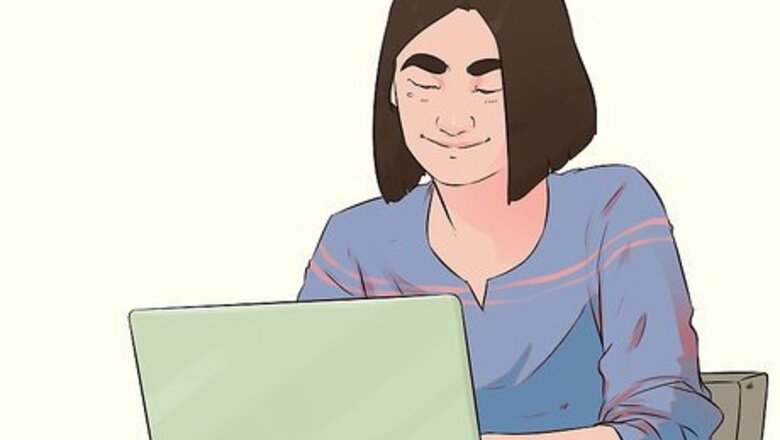
views
- Write formal letters for business, semi-formal letters to acquaintances or distant relatives, and casual letters to friends and close family.
- Start informal letters with a friendly greeting. Begin formal letters with your name and address, the date, and the recipient’s name and address.
- Write in clear language so the reader knows what you want to communicate. Sign off with a closing that matches the tone of the letter.
Writing a Formal Letter

Know when to write a formal letter. Write a formal letter when addressing someone you only know in a professional capacity. This includes letters written to government departments or businesses, instead of a known individual. These letters should be typed, then printed. You can use any text editing software to do this, such as Microsoft Word, OpenOffice, or Text Edit. If the letter is urgent or the recipient prefers email, you can send an email instead. When addressing your current boss or coworker, you can be slightly less formal. Email is usually fine, and you don't need an address at the top of the page.
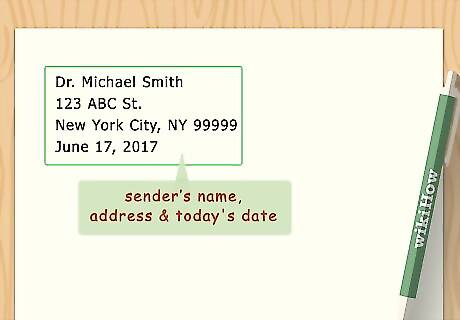
Write your address and today's date at the top of the page. Write your name and address at the top of the page, on the left. If you are writing a business letter, use the company name and address instead, or just write on company letterhead. Either way, skip two lines and write today's date. Write out the full date. 19 September 2014 (British) or September 19, 2014 (American) are both preferable to Sept. 19, 2014 or 19/9/14. Skip the date when writing an email.

Write the name and address of the recipient. Unless you're writing an email, skip another two lines and write the contact information for the person you're writing to. Write each of these on a separate line: Full title and name Company or organization name (if applicable) Full address (use two or more lines, as needed)
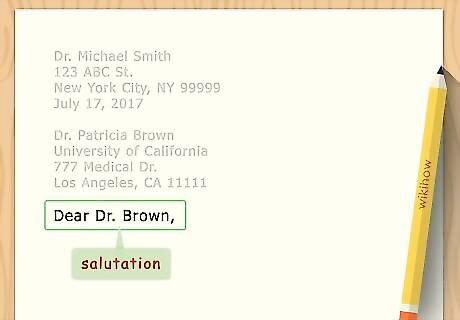
Write the salutation. Skip a line again, then greet the recipient with "Dear" followed by their name. You may use the last name, or the full name (first and last), but never the first name alone. Include an abbreviated professional title if applicable. If you know the job title but not the person's name, you may write "Dear Health Inspector:" or a similar phrase. It's usually possible to find the name with an online search, so try that first. If you don't have a specific contact, write "Dear Sir or Madam:" or "To Whom It May Concern:". These sound a little stiff and old fashioned, so try to avoid it when possible.
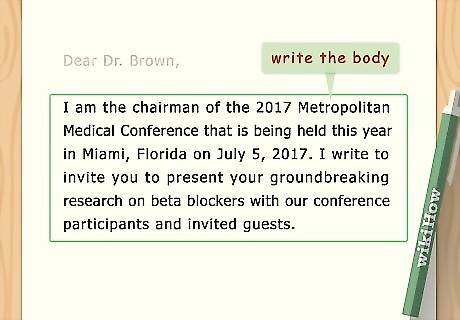
Write the letter. Formal letters should open with a clear statement of purpose. Do not use contractions (write are not instead of aren't), and phrase questions formally (Would you be interested in...? instead of Do you want to...?). Proofread the letter for spelling and grammar when finished, or ask a friend to help you. If you are writing on official business, keep it short and direct. If you are writing a distant relative or an acquaintance for social reasons, you can be a little more conversational. It's still best to keep it to under a page.
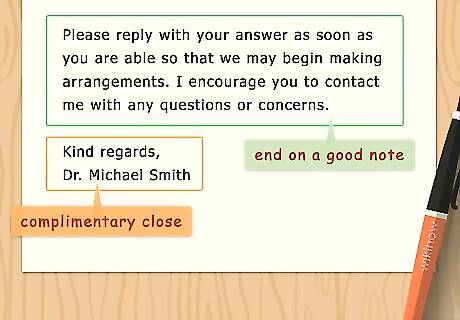
Use a complimentary close. A complimentary close ends your letter on a good note and establishes a connection with the recipient. Make two hard returns after the last paragraph of the letter, then write the complimentary close. For formal letters, stick to "Sincerely yours," "Kindest regards," or "Best wishes." Sign underneath the close, as follows: For typed formal letters, leave about four spaces between the complimentary close and your typed full name. Print the letter, then sign your name in blue or black ink in that blank space. In a formal email, type your full name after the complimentary close. You may use a courtesy title for yourself when you put your name at the end of a formal letter. For instance, a married woman could sign as "Mrs. Amanda Smith."
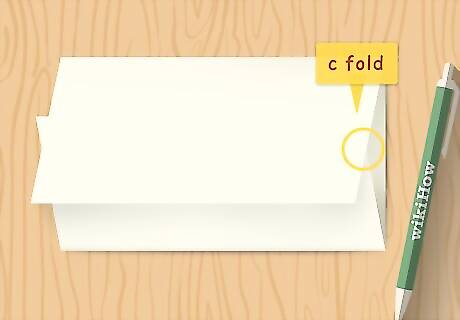
Fold the letter (optional). If you're sending a letter through the post, fold it into thirds. Bring the bottom of the sheet up so that it's two-thirds of the way up the page, and crease. Then fold down the top portion so that the crease matches up with the bottom of the paper. Folding the letter this way ensures that it will fit into most envelopes.
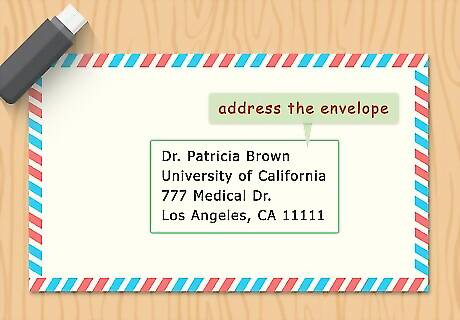
Address the envelope (optional). Find the center of the envelope, both lengthwise and widthwise. This is where you'll write the full address of the recipient, like so: Mr. John Smith 123 ABC St. New York City, NY 99999
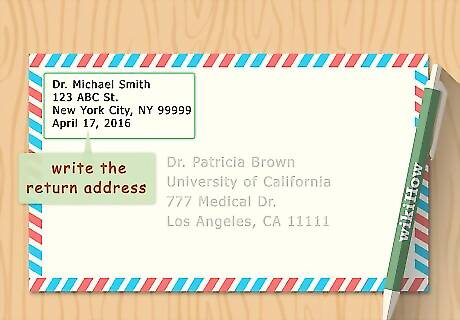
Write your return address on the envelope (optional). If the US Postal Service cannot deliver your letter for any reason, it will send the letter back to the return address at no extra charge. Write it as you would the address of the recipient (listed above); the only change is that you might wish to simply list your last name instead of your full name.
Writing an Informal Letter

Decide how formal your letter needs to be. How you write the letter will depend on your relationship with the recipient. Consider these guidelines: If you're writing to a distant or elderly relative, or a social acquaintance, write a semi-formal letter. If that person has sent you emails before, you may email them as well. If not, a handwritten letter is a safer bet. If you're writing a friend or close family member, an email or handwritten letter are both fine.
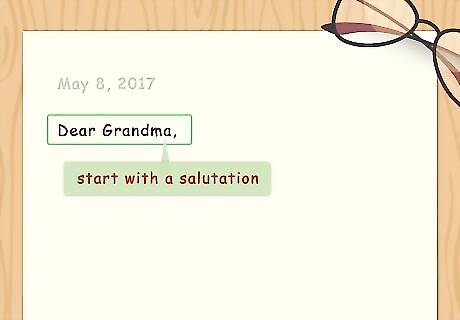
Start with a salutation. The salutation you use will depend on your relationship with the recipient of the letter, as well as the formality of the letter. Here are some possibilities: If you're writing a semiformal letter, you might use "Dear" or "Hello" as a salutation. Use the first name if that's how you talk to each other, or the courtesy title (Mr or Ms) if not. If you're writing an informal letter, you can use "Dear" or "Hello," as well as more informal greetings such as "Hi" or "Hey." Follow it with the first name.
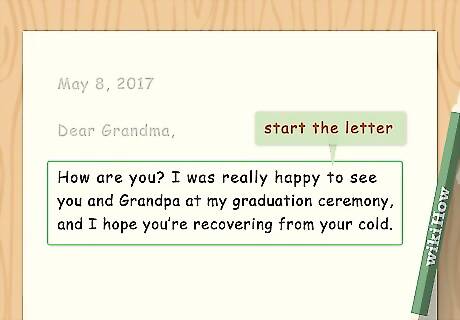
Start the letter. Move to the next line and start writing. If you're writing a personal letter, start by asking after the recipient's well-being. This can be as formal as "I hope you are well" or as informal as "How's it going?." Imagine the recipient is in front of you; how would you talk to them?
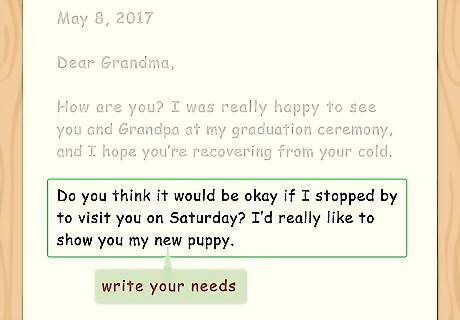
Write what needs to be communicated. The primary purpose of a letter is communication. Let the other person know what's going on in your life, including the details. For example, don't just tell your grandma "Thank you for the gift" — show her that it means something to you: "My friends and I spent all night playing the game you sent me. Thank you!" Whatever the subject is, sharing information should be the focus of the letter. Know what not to write. A letter written in anger or to solicit pity is probably not a letter you should send. If you've already written such a letter and you're unsure about sending it, let it sit for a few days before you pop it into the mailbox — you might change your mind.

End the letter. For informal letters, your close should reflect your relationship with the recipient. If you're writing to a spouse, dear friend, or close family member, you could use "Affectionately," "Fondly" or "Love." For a semiformal letter, you might find a better match with "Sincerely," "Regards," or "Best." A very old-fashioned close fits into the last sentence. This was originally a formal style, but you can have fun with it when writing a light-hearted letter to a friend. For example, the last paragraph of your letter could read "I remain, as ever, your devoted servant," and then your name. If you want to add something after the letter's written, use P.S, which means Postscript ("after the writing").

Send the letter. Insert the letter in an envelope. Stamp it, address it to the other person, and send it on its way.


















Comments
0 comment